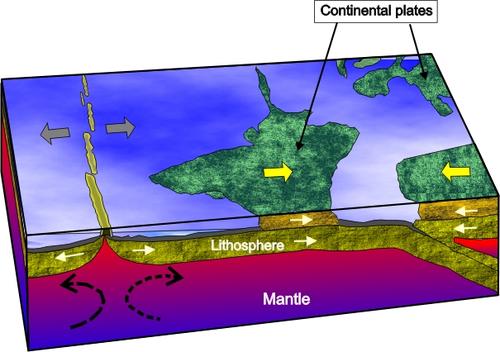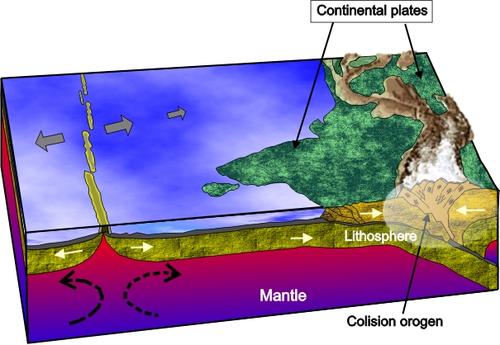2. Collision Metamorphism
Metamorphism due to continent-continent collision (1)
Image Credit: MBG
Metamorphism due to continent-continent collision (2)
Image Credit: MBG
When ocean basins close it is inevitable that the opposing areas of continental crust will be brought together. This may be a relatively passive process, with little overthrusting, or may lead to one mass of continental crust being thrust over the other to produce greatly overthickened crust as demonstrated in the Himalayas. If the continental crust on the subducting plate has been appreciably thinned, there may be a period of deep underthrusting or subduction of continental crust prior to collision. The present study of collision belts shows that there is typically a baffling diversity of metamorphic phenomena because the rocks may include older metamorphic basement, metamorphic rocks formed in the same convergence event prior to collision, metamorphic rocks related to the collision itself, and also the products of the contact effects of collision-related magmatism. The Alpine-Himalayan chain provides the most spectacular example of a collision orogeny from the relatively recent geological past. Indeed, collision is continuing today along parts of its length. The dramatic alpine structure led Argand to recognize the major role of large-scale horizontal movements in the formation for the Alps long before development of plate tectonic theory.
A distinctive feature of the Alpine chain is that high-pressure metamorphism has affected extensive late Paleozoic to Mesozoic platform sediments with abundant carbonates, together with the continental basement rocks. Apart from the scattered ophiolite fragments, the rocks involved are quite different from those of typical circum- Pacific, high-pressure belts. In the Alps, high-pressure metamorphism affects mature sediments, such as aluminous pelites and quartzites, and also granitic basement, whereas in the typical Pacific belts it affects immature greywackes.
In the Himalayas, it is now becoming apparent that there are general similarities in the metamorphic evolution to the Alps. The development of suture zone in southern Tibet, where metamorphic effects produced in earlier orogenies and at continental margins have become juxtaposed, and the effects of the Eocene collision of the Eurasian and Indian plates have been superimposed .
Rapid crustal thickening during continental collision produces high temperatures due to the large amount of radiogenic elements in the continental crust. The pressures are moderate because continental crust is usually never thicker than ~75 km (2.5 GPa). Cooling to a normal cratonal geotherm follows these abnormally high temperatures. This is the cause of so-called "Barrovian" metamorphism, of which typical minerals are staurolite and kyanite (disthen). Good examples are known from the Tibet and the Himalaya. The geological history of India - Asia is a sequence of continental collisions in the Triassic, Late Cretaceous and Tertiary (~50 Ma to recent). The present-day high elevation (5 km) of the plateau is believed to be related to large-scale crustal thickening, combined with delamination of the mantle lithosphere and asthenosphere reaching to unusually shallow levels. Continental thickening can lead to interesting kinds of melts and residuum that subsequently influence the deformation and evolution of the orogen.pressure belts. In the Alps, high-pressure metamorphism affects mature sediments, such as aluminous pelites and quartzites, and also granitic basement, whereas in the typical Pacific belts it affects immature greywackes.

